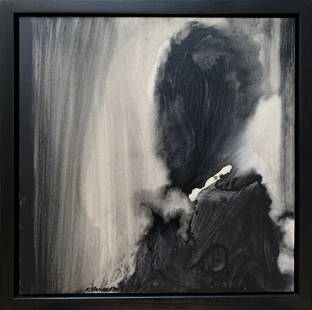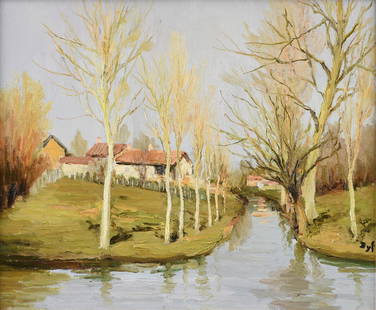
1930s Draper "Mud Head" Painting a la Henry Hensche
Similar Sale History
View More Items in PaintingsRelated Paintings
More Items in Paintings
View MoreRecommended Art
View More




Item Details
Description
William Franklin Draper (American, 1912-2003). Oil on board, ca. 1930s. A wonderful "mud head" painting on board most likely created by William Draper when he was a student of Henry Hensche in the 1930s. Hensche had learned this method of teaching color perception from Charles Hawthorne. Hensche asked his students paint colored blocks in sunlight, thus allowing the students to focus on the study of color without being distracted by line and drawing concerns. This "mud head" study depicts a seated figure wearing a white short-sleeved shirt with a cornflower blue collar and trim adorning the sleeves as well as matching shorts. The figure is posed with his back to the sun, sitting upon a ledge with his hands placed to either side of his thighs and his legs dangling over the edge. Size: 23.875" L x 19.875" W (60.6 cm x 50.5 cm)
The Henry Hensche Foundation website provides the following description of Charles Hawthorne's teaching approach, "A model, often one of the local Portuguese fisherman's children, posed on the beach, sitting on a barrel with their back to the sun. The students positioned their easels facing the shadow side of the model. Hawthorne instructed them to paint this dramatic silhouette against the blaze of light on the beach, the water, and emanating from the sky. By having his students paint with a large, unwieldy putty knife, it forced them to concentrate on the large shapes of color, rather than outlines around the shapes, the way one might do when painting with a brush. The quality of a study was judged by the effectiveness with which the light was suggested by these simple shapes of color. The resulting mud-like color of the face in shadow gave rise to the studies' nickname, 'mud head'."
Henry Hensche who was Charles Hawthorne's teaching assistant in 1928 and had studied with him for 9 summers adopted this teaching method in the 1930s, but adapted it a bit. Instead of putty knives which were very cumbersome, he had the students use painting knives. In addition, Hensche simplified the "mud head" technique even more by having students paint colored blocks in sunlight, thus liberating them from the drawing concerns of portraiture. In addition, Hensche had students model forms with color changes - refining the large color shapes or "main masses" into subdivisions known as "major variations". According to the Hensche Foundation, "In this way forms are modeled with color changes, within a given 'light key'. The term 'light key' refers to the quality of the light illuminating the subject - whether the subject is seen on a cloudy day vs. a sunny day, indoor vs. outdoors, early morning vs. late afternoon light, and all points in between."
Hensche oftentimes quoted Cezanne's proclamation that "every form change is a color change" and was regarded as "an unparalleled colorist - a painter justly deserving the artistic lineage that extends back just two generations to the seminal American impressionist, William Merritt Chase." Having taught for over 60 years, Hensche ignited an immense appreciation for nature's color and light in his students. Hensche won the Pulitzer Traveling Prize from Columbia University and the Halgarten Award from the National Academy of Design between 1922 and 1930. His work was exhibited at The Art Institute of Chicago, The Corcoran, The Pennsylvania Academy of Fine Arts, and numerous solo exhibitions. William Draper was among Hensche's most successful students, along with Franz Kline and Nelson Shanks.
This painting comes to us from the Estate of William F. Draper, an American artist who studied with Henry Hensche in Cape Cod. Hensche studied at the Art Students League in New York City. By the summer of 1919, he arrived in Provincetown and studied with Charles Webster Hawthorne (American, 1872-1930) at the Cape Cod School of Art (est. 1899). Hensche admired Hawthorne's "color note" approach to painting and even saw this as an advance beyond Claude Monet and William Merritt Chase. "Monet was a painter; he didn't teach. What was needed was a way to put his principles into some kind of teachable form...in the America of that day, William Merritt Chase was the most famous teacher. He taught Hawthorne - and almost everyone else. But, he never really came to grips with the Impressionists' idea. His paintings were really done in tone - in black and white - with Impressionists colors added. He never developed a clear method."
Provenance: The William F. Draper Collection, New York City, USA, acquired via descent from the late William Franklin Draper (1912-2003), an accomplished American artist whose career spanned seven decades. Known as the "Dean of American Portraiture," William Draper was the only artist to paint President John F. Kennedy from life, and his oeuvre includes marvelous landscapes from his world travels, military paintings as he was one of only seventeen Combat Artists in WWII, and portraits of illustrious individuals.
All items legal to buy/sell under U.S. Statute covering cultural patrimony Code 2600, CHAPTER 14, and are guaranteed to be as described or your money back.
A Certificate of Authenticity will accompany all winning bids.
PLEASE NOTE: Due to recent increases of shipments being seized by Australian & German customs (even for items with pre-UNESCO provenance), we will no longer ship most antiquities and ancient Chinese art to Australia & Germany. For categories of items that are acceptable to ship to Australia or Germany, please contact us directly or work with your local customs brokerage firm.
Display stands not described as included/custom in the item description are for photography purposes only and will not be included with the item upon shipping.
#153736
The Henry Hensche Foundation website provides the following description of Charles Hawthorne's teaching approach, "A model, often one of the local Portuguese fisherman's children, posed on the beach, sitting on a barrel with their back to the sun. The students positioned their easels facing the shadow side of the model. Hawthorne instructed them to paint this dramatic silhouette against the blaze of light on the beach, the water, and emanating from the sky. By having his students paint with a large, unwieldy putty knife, it forced them to concentrate on the large shapes of color, rather than outlines around the shapes, the way one might do when painting with a brush. The quality of a study was judged by the effectiveness with which the light was suggested by these simple shapes of color. The resulting mud-like color of the face in shadow gave rise to the studies' nickname, 'mud head'."
Henry Hensche who was Charles Hawthorne's teaching assistant in 1928 and had studied with him for 9 summers adopted this teaching method in the 1930s, but adapted it a bit. Instead of putty knives which were very cumbersome, he had the students use painting knives. In addition, Hensche simplified the "mud head" technique even more by having students paint colored blocks in sunlight, thus liberating them from the drawing concerns of portraiture. In addition, Hensche had students model forms with color changes - refining the large color shapes or "main masses" into subdivisions known as "major variations". According to the Hensche Foundation, "In this way forms are modeled with color changes, within a given 'light key'. The term 'light key' refers to the quality of the light illuminating the subject - whether the subject is seen on a cloudy day vs. a sunny day, indoor vs. outdoors, early morning vs. late afternoon light, and all points in between."
Hensche oftentimes quoted Cezanne's proclamation that "every form change is a color change" and was regarded as "an unparalleled colorist - a painter justly deserving the artistic lineage that extends back just two generations to the seminal American impressionist, William Merritt Chase." Having taught for over 60 years, Hensche ignited an immense appreciation for nature's color and light in his students. Hensche won the Pulitzer Traveling Prize from Columbia University and the Halgarten Award from the National Academy of Design between 1922 and 1930. His work was exhibited at The Art Institute of Chicago, The Corcoran, The Pennsylvania Academy of Fine Arts, and numerous solo exhibitions. William Draper was among Hensche's most successful students, along with Franz Kline and Nelson Shanks.
This painting comes to us from the Estate of William F. Draper, an American artist who studied with Henry Hensche in Cape Cod. Hensche studied at the Art Students League in New York City. By the summer of 1919, he arrived in Provincetown and studied with Charles Webster Hawthorne (American, 1872-1930) at the Cape Cod School of Art (est. 1899). Hensche admired Hawthorne's "color note" approach to painting and even saw this as an advance beyond Claude Monet and William Merritt Chase. "Monet was a painter; he didn't teach. What was needed was a way to put his principles into some kind of teachable form...in the America of that day, William Merritt Chase was the most famous teacher. He taught Hawthorne - and almost everyone else. But, he never really came to grips with the Impressionists' idea. His paintings were really done in tone - in black and white - with Impressionists colors added. He never developed a clear method."
Provenance: The William F. Draper Collection, New York City, USA, acquired via descent from the late William Franklin Draper (1912-2003), an accomplished American artist whose career spanned seven decades. Known as the "Dean of American Portraiture," William Draper was the only artist to paint President John F. Kennedy from life, and his oeuvre includes marvelous landscapes from his world travels, military paintings as he was one of only seventeen Combat Artists in WWII, and portraits of illustrious individuals.
All items legal to buy/sell under U.S. Statute covering cultural patrimony Code 2600, CHAPTER 14, and are guaranteed to be as described or your money back.
A Certificate of Authenticity will accompany all winning bids.
PLEASE NOTE: Due to recent increases of shipments being seized by Australian & German customs (even for items with pre-UNESCO provenance), we will no longer ship most antiquities and ancient Chinese art to Australia & Germany. For categories of items that are acceptable to ship to Australia or Germany, please contact us directly or work with your local customs brokerage firm.
Display stands not described as included/custom in the item description are for photography purposes only and will not be included with the item upon shipping.
#153736
Condition
Areas of surface wear with minor scuffs and abrasions. Wear/loss to corners/peripheries as shown.
Buyer's Premium
- 26.5%
1930s Draper "Mud Head" Painting a la Henry Hensche
Estimate $1,300 - $2,500
6 bidders are watching this item.
Shipping & Pickup Options
Item located in Louisville, CO, usOffers In-House Shipping
Local Pickup Available
Payment

TOP











































!["La Tierra Y Su Fruta" Oil On Canvas: DESCRIPTION: Oil on canvas painting entitled "La Tierra y su Fruta", the central section depicting agricultural laborers. Signed "[?] Remedio" at left. Worn title at left. Unframed. CIRCA: Late 20th -](https://p1.liveauctioneers.com/1373/326919/176011069_1_x.jpg?height=310&quality=70&version=1713561897)





























